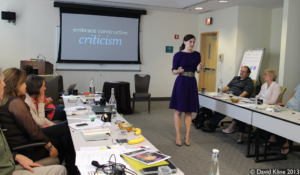Since March 2011, I have spent a considerable amount of time with research scientists in the ocean acidification community – attending meetings, organizing conference symposia, prepping them for policy briefings, and leading them through communication workshops. In this time, I’ve seen the breadth of research and number of scientists working on ocean acidification increase dramatically.
This expansion has led to an “era of nuance,” as we noted after last year’s international gathering of 400+ ocean acidification scientists. The stark cases of how ocean chemistry impacts US West Coast oyster hatcheries now stand side-by-side with discoveries of more complex effects on marine species and what this means for things people care about (e.g. fisheries, coastal protection, cultural traditions). But what stands out is that even with this growing complexity, the community has confronted the hard scientific questions head on AND tackled the tricky communication challenges with equal enthusiasm and commitment.
In September 2013, ~200 scientists assembled in Washington, DC at the second US Ocean Acidification Principal Investigators (OAPI) Meeting to talk about what we already know about ocean acidification and where the field is going next. Granted this not an unusual goal for a scientific conference, but the way this community went about it was definitely atypical.
For one, the organizers designed the 3-day meeting to focus on conversations rather than endless presentations. The breaks and lunches were long enough to really engage with colleagues and although the group did meet in plenary frequently, the emphasis was on digging deeper into particular topics in breakout groups. As Karen talked about recently, it is this kind of thoughtful design that can help a potentially great convening live up to its expectations. But the most significant strategy was not about form, but about content. The theme of both doing AND communicating ocean acidification ran through the entire week.
To start, just prior to the larger OAPI meeting, COMPASS held our second two-day ocean acidification communication workshop. The 21 scientists at this workshop tackled the challenge of not only getting to the core message of their own science, but also joining forces to address big questions like “So, what does this really mean for things people care about?” or “What should we do about it?”
Then there was a seamless transition into the OAPI Meeting itself as eight of the scientists and journalists from our workshop kicked off the larger meeting with a panel discussion about why engaging with the media is so important. This event clearly signaled that the communication flag was flying from the get go. The theme continued with a plenary talk again focused on communicating science with the media and a COMPASS lunchtime workshop on the Message Box.
Finally, the week wrapped up with four scientists from the community heading to Capitol Hill for a science briefing on what we’ve gotten after the first decade of intensive ocean acidification research and where things need to go next.

Liz Neeley reminds scientists at the communication workshop to support each other and embrace constructive criticism when facing both scientific and communication challenges ahead. Photo © David Kline 2013
To be clear, one meeting does not a communication revolution make. It is not just that this research community invested in thinking about communication for that week, but instead the series of events were a natural extension of ongoing conversations that have resulted in things like the Ocean Acidification FAQ resource and 20 Facts About Ocean Acidification.
These are scientists who, even in this “era of nuance,” willingly talk to journalists about their research and take time to serve on government panels about the topic. They understand that it is ongoing engagement and relationship building with those outside of the research community that will ultimately position them to be trusted navigators and lead to their science having the greatest impact on society. And I, for one, can’t wait to see what they do next….



